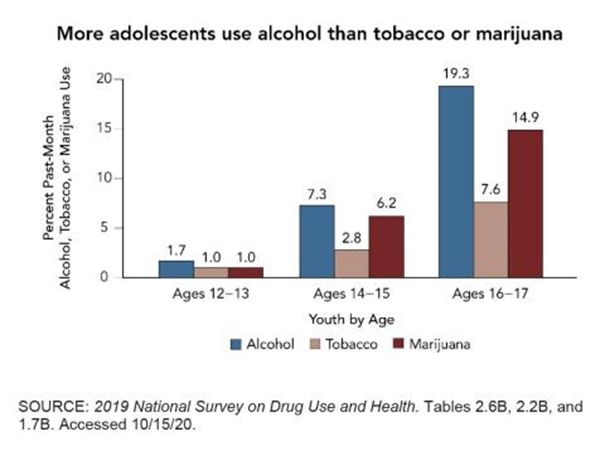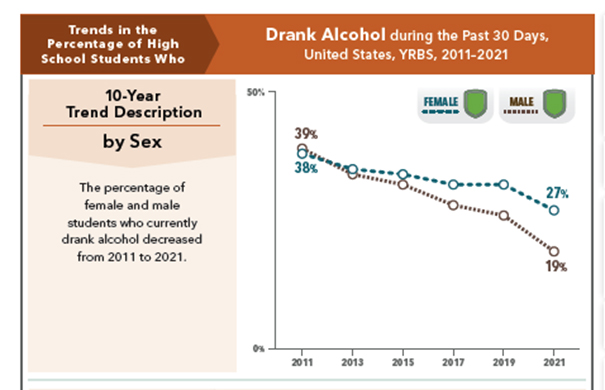Of the 19 million undergraduate students enrolled in college in 2018, 9 million were under age 21, the U.S. minimum legal drinking age.
During the past 30 days among college students:
- 53% drank alcohol
- 33% binge drank
- 8% were heavy alcohol users (binge drinking on five or more days in the past 30 days)
- Membership in fraternities and sororities is associated with increased rates of binge drinking and marijuana use.
- 42 % of student athletes reported binge drinking in 2018
- 71% to 93% of male college athletes report drinking alcohol in the last year.
Definition of a drink
In the United States, a standard drink is defined as any beverage containing 0.6 fluid ounces or 14 grams of pure alcohol (also known as an alcoholic drink equivalent), which is found in:
- 12 ounces of beer with about 5 percent alcohol content
- 5 ounces of wine with about 12 percent alcohol content
- 1.5 ounces of distilled spirits with about 40 percent alcohol content.
Definition alcohol impairment
Alcohol is a toxic substance and any level in the blood disrupts the normal functioning of a person’s nervous system. In most states a person is legally considered intoxicated and too impaired to drive when their blood alcohol concentration (BAC) reaches 0.08 %. Some states may reduce the allowed level to 0.05%. Depending on the state, the “zero tolerance” limit for drivers under 21 years of age is set at 0.00% to 0.02%. Women weighing 180 pounds or less and men weighing 140 pounds or less will exceed the 0.08% limit if more than one drink is consumed.
Underage and College Drinking Is Dangerous
Risks and negative consequences include:
- Many deaths. Alcohol is a significant factor in the about 1500 deaths a year from motor vehicle crashes, homicides, alcohol overdoses, falls, burns, drowning, and suicides.
- Many accidents and injuries such as from motor vehicle crashes, falls and burns. In 2011 about 188,000 people younger than age 21 visited an emergency room for alcohol-related injuries.
- Physical problems, such as hangovers or illnesses.
- Impaired judgment. Drinking can lead to poor decisions about taking risks, including unwanted, unplanned, and unprotected sexual activity, drinking and driving, and aggressive or violent behavior.
- Increases the risk of physical and sexual assault and an increased likelihood of being the victim or perpetrator of interpersonal violence.11 One in 5 college women experience sexual assault during their time in college and a majority of these assaults involve alcohol or other substances.
- About 1 in 4 college students report academic consequences from drinking, including missing class, falling behind in class, doing poorly on exams or papers, and receiving lower grades overall.
- Other serious problems such as vandalism, trouble in school, lack of participation in youth activities, trouble with the law and use of other substances.
- Athletic performance is impaired for up to 24 hours after just one or two drinks.
- Increases the risk of alcohol problems such as alcohol use disorder (AUD) later in life.
- Impaired brain development. Because people’s brains keep developing well into their 20s. alcohol can alter brain structure and function. This may cause cognitive or learning problems and increased vulnerability for alcohol use disorder AUD.
In general, the risk of youth experiencing these problems is greater for those who binge drink than for those who do not binge drink.
Why Youth Drink
Adolescents often seek independence, new challenges, and engage in behavior they know has some risks even when there is parental and social disapproval. As with adults, the pleasurable effects of alcohol are sought. These include:
In addition there are many social and environmental factors that support use of alcohol. They include:
- Peer pressure comes from many sources including friends, relatives, coworkers, athletic team members, fraternity and sorority members. Students often consider drinking to be a ritual that is an integral part of their college experience.
- Community and social cues create a culture favorable for and tolerant of the consumption of alcohol, especially it is conveyed by media, including advertising that portrays consumption of alcohol to be desirable, sophisticated, and appropriate in many settings.
- Easy access is highly correlated with increased consumption. In 2019, among adolescents ages 12 to 14 who reported drinking alcohol in the past month, 96.5% reported getting it for free. In many cases, adolescents have access to alcohol through family members or find it at home.
Underage and college drinking can be decreased
Total prevention of underage and college drinking is unlikely but there are many effective strategies for diminishing excessive drinking. Research suggests that a combination of individual- and environmental-level interventions will be the most effective way to reduce harmful and underage student drinking. Successful efforts typically involve a mix of strategies that target individual students, the student body as a whole, and the broader college community. A major goal is to reduce the availability of alcohol because research shows that reducing alcohol availability cuts consumption and harmful consequences on campuses as well as in the general population.
Strategies at the community and policy level include:
- Increasing alcohol taxes
- Commercial sales establishment liability laws (examples include bars, taverns, and restaurants). Unfortunately, these establishments depend on the college clientele for their financial success.
- Banning alcohol on campus
- Students derive their expectations of alcohol from
- Regulating the number and concentration of alcohol outlets
- Enforcing laws prohibiting alcohol sales to minors and banning two for the price of one, ladies night and other promotions
- national media campaigns targeting youth and adults
- reducing youth exposure to alcohol advertising
- comprehensive community-based programs
- Screening and behavioral counseling interventions by a primary care provider or other health practitioner (e.g., pediatrician)
- Individual-level interventions with information and norms clarification that target students, including those in higher risk groups such as first-year students, student athletes, members of Greek organizations, and mandated students.
Parents, teachers, and other individuals can help youth avoid alcohol problems by:
- Talking about the dangers of drinking
- Drinking responsibly, if they choose to drink
- Serving as positive role models in general
- Not making alcohol available
- Connecting with other parents about sending clear messages about the importance of youth not drinking alcohol
- Supervising all parties to make sure there is no alcohol
- Encouraging kids to participate in healthy and fun activities that do not involve alcohol.
Professional treatment options include:
- Attending individual or group counseling sessions one or more times per week
- Receiving a prescription from a primary care doctor or psychiatrist to help reduce alcohol cravings
- Participating in family therapy to build a supportive foundation for recovery
Alcohol Overdose and College Students
Thousands of college students are transported to the emergency room each year for alcohol overdose, which occurs when there is so much alcohol in the bloodstream that areas of the brain controlling basic life-support functions—such as breathing, heart rate, and temperature control—begin to shut down. Signs of this dangerous condition can include the following:
- Mental confusion, stupor
- Difficulty remaining conscious or inability to wake up
- Vomiting
- Seizures
- Slow breathing (fewer than eight breaths per minute)
- Irregular breathing (10 seconds or more between breaths)
- Slow heart rate
- Clammy skin
- Dulled responses, such as no gag reflex (which prevents choking)
- Extremely low body temperature, bluish skin color, or paleness
Alcohol overdose can lead to permanent brain damage or death, so a person showing any of these signs requires immediate medical attention. Do not wait for the person to have all the symptoms, and be aware that a person who has passed out can die. Call 911 if you suspect alcohol overdose.
References:
Underage drinking:
National Institute on Alcohol Abuse and Alcoholism https://www.niaaa.nih.gov/publications/brochures-and-fact-sheets/underage-drinking
For information on individual- and environmental-level strategies, visit NIAAA's CollegeAIM (College Alcohol Intervention Matrix) guide: https://www.collegedrinkingprevention.gov/CollegeAIM
CDC on Underage Drinking:
https://www.cdc.gov/alcohol/fact-sheets/underage-drinking.htm#print
Athletes and alcoholism:
https://alcoholrehabhelp.org/blog/athletes-alcoholism/
A Call to Action: Changing the Culture of Drinking at U.S. Colleges
“NIAAA Task Force: A Call to Action.” www.collegedrinkingprevention.gov.
 |

|
 |



